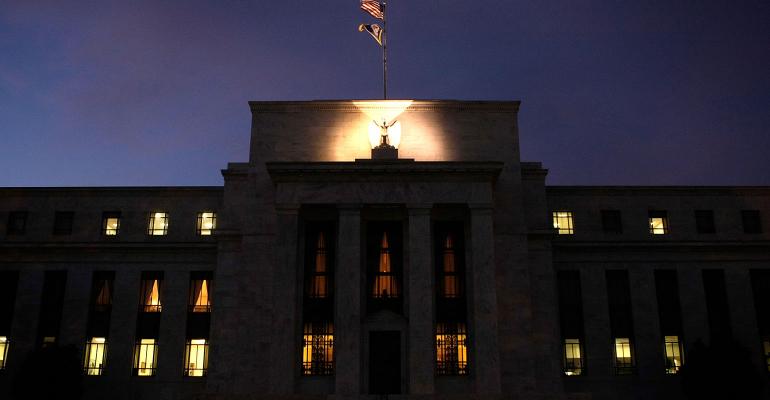By Brian Chappatta
(Bloomberg) --For two of the biggest private holders of Treasuries, bond-market signals in the past week are nothing but noise when it comes to betting on the Federal Reserve.
Goldman Sachs Asset Management and Vanguard Group Inc., which oversee a combined $5 trillion, say they’re taking Fed officials’ word that they’re on track to raise rates next month. Holding to that conviction hasn’t been easy lately for money managers: Market-implied bets on a hike have been whipsawed by the political storm buffeting the White House, and breakeven inflation rates are near the lowest since November.

Those bond-market signals bear watching as investors assess the prospect of additional rate hikes beyond June. The odds of a rate boost next month have rebounded to about 70 percent, from 57 percent Wednesday, based on the current effective fed funds rate and the forward overnight index swap rate. While down from 80 percent last week, lessons from March have investors reluctant to bet against the Fed when policy makers have made clear that the path of rates is likely higher.
“It’s day-to-day market noise,” said Greg Davis, global head of fixed income at Vanguard. The money manager is the largest private holder of Treasuries, according to data compiled by Bloomberg.
Davis spoke Thursday, the day after the S&P 500 Index fell the most in eight months. He said he doesn’t expect yields to fall much further without significant deterioration in the outlook for stocks or the economy.
“The Fed has been very clear in their desire to get further along in terms of the normalization process,” he said. “They’re going to continue on that path unless there’s something that gets in their way, and we don’t believe the data that’s come out recently has been weak enough.”
See this for more on why the Fed is likely to stay the course.
Inflation has missed forecasts in recent months, with the core consumer price index slipping below 2 percent for the first time since 2015. The market for inflation-linked debt suggests some investors are questioning whether the central bank can reach its target of 2 percent price growth. The yield spread between 10-year Treasuries and similar-maturity Treasury Inflation Protected Securities sank as low as 1.78 percentage points Thursday, the narrowest since Nov. 9.
At that level, investors appear to see inflation protection as a reasonable wager. Direct and indirect bidders together took a record amount of the Treasury’s 10-year TIPS auction Thursday.
The TIPS offering took place minutes before Cleveland Fed President Loretta Mester said she sees price growth rising to the central bank’s goal over the next year or so. She also repeated that the central bank must focus on not falling behind and looking through temporary market moves.
“They have a long ways to catch up to normalize policy, and they’re not going to be thrown off by a couple months of weaker inflation data,” said Mike Swell, co-head of global fixed-income portfolio management at Goldman Sachs Asset. “They’re still likely to do a couple of hikes this year as well as the beginning of tapering.”

That view is based on a forecast for stronger economic growth in the second half of 2017, coupled with moderate inflation increases, he said.
By at least one measure, economic data are falling short of market expectations lately. Citigroup Inc.’s U.S. Economic Surprise Index this week touched its lowest level in a year.
Yet the labor market continues to show signs of tightening, with jobless claims declining for the third straight week and benefit rolls matching the lowest since 1973, Labor Department data showed Thursday.
The unemployment rate, at 4.4 percent, is the lowest since 2007 and in line with what many Fed officials see as full employment.
“The Fed will most likely put a very heavy weight on the employment picture and how much growth we’ve had over the last 12 months,” said Matthew Scott, a senior bond trader at AllianceBernstein LP. “If you look at monetary policy as a seesaw, the strong employment data gives them greater cover to hike, despite the disappointing CPI data.”
To contact the reporter on this story: Brian Chappatta in New York at [email protected] To contact the editors responsible for this story: Boris Korby at [email protected] Mark Tannenbaum, Dave Liedtka




